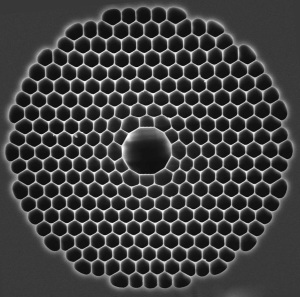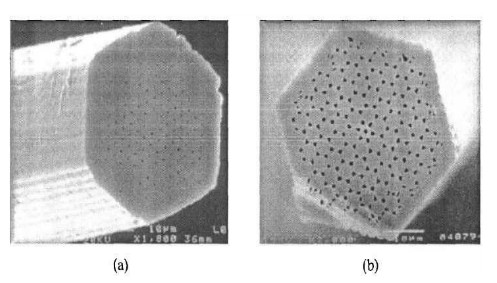Photonic Crystal Fiber
Photonic crystal fiber (PCF) is a new type of optical fiber that has emerged in recent years. This fiber is usually composed of a single medium and is composed of air holes that are closely arranged in two dimensions and keep the structure unchanged in the axial direction. Structural cladding. Photonic crystal fibers exhibit many characteristics that are difficult to achieve in traditional optical fibers, and thus have received widespread attention and become a hot spot in recent years in optical and optoelectronics research.
Background
academia and industry. However, the study found that although the fiber has a periodic cladding structure, it foThe concept of photonic crystal fiber was first proposed by St. J. Russell et al. In 1992. Its original intention was to introduce the photonic band gap effect in the optical fiber to realize the guidance of light. Limited by the preparation process, the first photonic crystal fiber was not successfully released until 1996. The optical fiber has unique endless single-mode transmission characteristics, causing great sensation in llows the total internal reflection (TIR) mechanism of traditional fiber and does not utilize the photonic band gap effect. Further analysis shows that the transmission characteristics of this type of fiber do not depend on the periodic arrangement of cladding pores. Under certain conditions, the randomly arranged pore structure can also achieve endless single-mode transmission. People call this type of optical fiber total internal reflection photonic crystal fiber (TIR-PCF) or refractive index guided photonic crystal fiber. The successful development of TIR-PCF has added new content to the definition of photonic crystal fiber and opened the prelude to the research of photonic crystal fiber technology.

Photonic crystal fiber microstructure
In 1998, J.C. Knight et al. Developed the first true "photonic crystal" optical fiber that relies on photonic bandgap to guide light. Different from TIR-PCF, this kind of fiber is called photonic bandgap fiber (PBG-PCF). In 1999, R.F. Cregan et al. Successfully developed a large air core light guide PBG-PCF. Using air as the light transmission medium means ultra-low transmission loss, ultra-low nonlinearity, and ultra-low dispersion transmission, which is difficult to achieve in traditional optical fibers. The advent of PBG-PCF announced that the photonic crystal fiber has been fully on the stage of history. Since then, photonic crystal fibers have entered a stage of rapid development, and have quickly occupied the forefront of research in many fields of science and technology. At present, the application research of photonic crystal fiber has gradually covered many scientific and technological leaders such as communication, sensing, nonlinear optics, spectroscopy, and even biomedicine. With the deepening of research, various new photonic crystal fibers are still emerging, and new applications based on photonic crystal fibers are also increasingly abundant.
Structure and light guide principle
In terms of structure, PCF can be divided into solid fiber and hollow fiber. The solid optical fiber is an optical fiber in which quartz glass capillaries are periodically arranged around the quartz glass rod. The hollow fiber is an optical fiber in which quartz glass capillaries are periodically arranged around the quartz glass tube.
PCF light guide mechanism can be divided into two categories: refractive index light guide mechanism and photon energy gap light guide mechanism.
Refractive index light guide mechanism: there is a certain difference between the refractive index of the core of the periodic defect (quartz glass) and the refractive index of the periodic cladding (air), so that the light can propagate in the core, this structure of PCF The light guide mechanism is still total internal reflection, but it is different from the conventional G.652 fiber. Because the cladding contains air, this mechanism is called improved total internal reflection. This is because the hole size ratio in the hollow core PCF The wavelength of the transmitted light is still small.

Photonic crystal fiber cross-section
Photonic band gap light guiding mechanism: In theory, the solution of the electromagnetic wave (light wave) in the photonic crystal can derive the conduction conditions of the solid core and hollow core PCF, and the result is the photonic band gap light guiding theory. As shown in Figure 1, the center is a hollow core. Although the refractive index of the hollow core is lower than that of cladding quartz glass, it can still ensure that light is not refracted out, because the lattice of small holes in the cladding constitutes a photonic crystal. When the distance between the small holes and the diameter of the small holes meet certain conditions, the corresponding light can be prevented from propagating within the range of the photon energy gap, and the light is restricted to propagate within the central hollow core. Recent studies have shown that this kind of HF can transmit more than 99% of the light energy, and the spatial light attenuation is extremely low, so the fiber attenuation may be only 1 / 2-2 / 1/4 of the standard fiber. But not all PCFs are photonic band gap light guides.
The specific explanation of the photon energy gap transmission mechanism of the hollow core PCF is: the periodic defect formed in the hollow core PCF is air, and the light transmission mechanism is to use the cladding to form a photon energy gap for light of a certain wavelength. Core-forming defects exist and propagate. Although total internal reflection cannot occur in the hollow core PCF, the lattice structure of small holes in the cladding is like a mirror, so that light is reflected multiple times at the air and quartz glass interface of many small holes.
Advantage
(1) The photonic crystal waveguide has an excellent bending effect.
(2) There is basically no loss of energy transmission, and there will be no delays and other phenomena that affect the data transmission rate.
(3) The optical fiber made of photonic crystal has an extremely wide transmission frequency band and can be transmitted in the whole band.
Characteristic
PCF has many singular characteristics:
(1) Endlessly Single Mode
The transmission of ordinary single-mode optical fiber will become multi-mode optical fiber as the core size increases. As for the PCF, as long as the ratio of the air aperture to the hole pitch is less than 0.2, no matter what wavelength can be single-mode transmission, there seems to be no cut-off wavelength. This is the single-mode transmission characteristic without cutoff. This fiber can be transmitted in single mode under the light wave from blue light to 2μm. What is more peculiar is that this characteristic has nothing to do with the absolute size of the fiber, so the mode field area can be adjusted by changing the air hole spacing. It can reach 1 ~ 800 μm2 at 1 550 nm. In fact, a large mode field PCF of 680 μm2 has been made, which is about 10 times that of conventional optical fiber. The small mode field is conducive to the generation of nonlinearity, and the large mode field can prevent the occurrence of nonlinearity. This is of great significance for improving or reducing optical nonlinearity. This kind of optical fiber has many potential applications, such as lasers and amplifiers (using highly nonlinear optical fibers), optical fibers for low-nonlinear communications, and high optical power transmission.
(2) Unusual chromatic dispersion
The material dispersion in vacuum is zero, and the material dispersion in air is also very small. This makes the dispersion of the air core PCF very special. Because the fiber design is very flexible, as long as the ratio between the aperture and the hole spacing is changed, a large waveguide dispersion can be achieved, and the total chromatic dispersion of the fiber can be achieved to the desired distribution. For example, the zero-dispersion wavelength can be moved to a short wavelength, which leads to the realization of optical arc sub-transmission at 1 300 nm; a dispersion-flattened fiber with excellent properties (the bandwidth of hundreds of nm is close to zero dispersion); various non-linear devices and dispersion compensation fiber Up to 2000ps / nm · km) came into being.
(3) Excellent nonlinear effect and birefringence effect
The non-linear effect that appears in G.652 fiber is a phenomenon that the transmission intensity per unit area of the fiber is too large, which seriously damages the transmission quality of the system. However, in the photonic band gap light guide PCF, we can reduce the light intensity per unit effective area by increasing the diameter of the PCF core air hole (ie, the effective area of the PCF), thereby greatly reducing the nonlinear effect. This characteristic of photonic band gap light guiding lays the technical foundation for the manufacture of large effective area PCF.
(4) Excellent birefringence effect
For polarization-maintaining fibers, the stronger the birefringence effect and the shorter the wavelength, the better the polarization state of the transmitted light. In PCF, it is only necessary to break the circular symmetry of the PCF cross section to form a two-dimensional structure to form strong birefringence. By reducing the number of air holes or changing the diameter of air holes, a high birefringence PCF polarization maintaining fiber that is several orders of magnitude higher than the commonly used Panda polarization maintaining fiber can be manufactured.
Application
Application areas:
High power low loss near infrared laser transmission
Pulse shaping, pulse compression
Nonlinear optics
Fiber optic sensing field
New application:
(1) Super continuous generation
(2) Pulse compression
(3) Tunable fiber coupler


















View More(Total0)Comment Lists